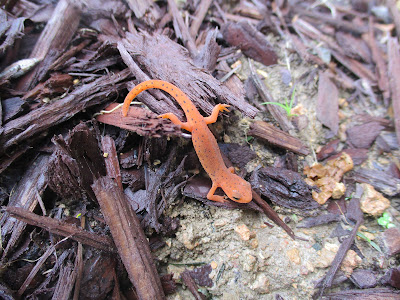Sabbath quiet on the east porch. Mottled sunshine over the garden, a drift of clouds, pale grey at the edges.
Whirring of wings as hummingbirds land on the hanging feeder. Bluebirds fly into the fringe of trees that line the south ravine, dart back out of sight behind the house.
I move the heavy gardening book from my lap to rest against the arm of the rocking chair. Clancy, the half grown kitten, has landed in my lap.
A light breeze lifts the perfume of the Old Vermont Pinks in the new garden below. The tallest spires of foxglove move.
I am lost in my book--English gardens, herbs, flowers, stately formal gardens, cottage gardens, rustic country plots.
The wind quickens, bringing the smell of distant rain. Putting the book aside, I watch the tops of the trees swaying as dark clouds move in from the west.
A muffled rumble of thunder and the cats who have kept me company exit the porch, scudding through the sun room and into the house.
Rain moves in fast, great sheets of it borne on the wind.
Through the porch screens I watch as water pummels the flower strips, splashes from the barn roof.
Picking up my book and a cushion from the rocking chair I follow the cats inside.
The shower is brief, but rather fierce, over in a scant 15 minutes.
Outside again trees drip, closer by, the eaves drip.
The tiny tree frogs we call 'rain crows' make their distinctive creaking sound, call and answer from several across the lane.
A quarter of an hour's respite and again the thunder rolls, heralding another deluge.
Teasel-Cat and I settle for a chair by the east living room windows, the book again positioned to accommodate a cat
When the rain stops I shove my feet into boots and venture outside.
In the greenhouse a swallowtail butterfly beats against the wall, pauses to cling to a spray of tall grass above the bench. I grasp it gently by one wing, release it at the door and watch as it flutters away.
The storms have moved off, leaving a steamy warmth. The peonies raise their heads.
The sky is brilliantly blue, clouds pillowy, pristine.
Walking up the lane to the mailbox I note that this shapely tree in the fence row has triumphed over the harsh freeze that stripped its first crop of leaves.
Our neighbor's barn lot, unused since the death last fall of his giant jack, has grown a cover of buttercup.
The dooryard shimmers, the air has a rain-washed freshness.
The grass of the meadow is nearly ready for David Beachy to hay again.
Willis waits for me in the shade where the lane bends past the garden area.
Willis takes his escort duties very seriously.
At twilight we walk out and notice that the rain and several hours of steamy heat have caused a veritable explosion of green beans poking through the wet garden soil.
It is nearly dark when I cross the yard to close up the greenhouse.
A few seedlings need watering.
Jim has set buckets to collect rain water, better for the young plants than the heavily chlorinated county water.
A frog balanced on the edge of a bucket startles me, plopping over the edge.
The night air is heavy with the scent of wet grass, pinks, pansies, wild blackberries.
The rain crows rasp, the birds have gone to their night time roosts.
We are--finally--at the edge of summer.





















































